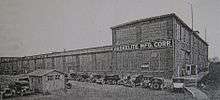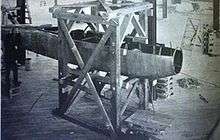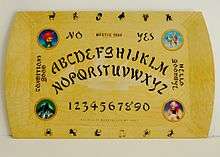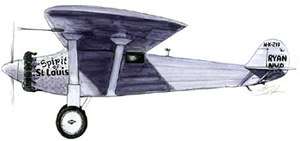Haskelite Manufacturing Corporation
Haskelite Manufacturing Corporation (1917–1956) was a conglomerate of Michigan–based companies. It was located on Broadway Avenue in Grand Rapids, Michigan. They manufactured haskelite plywood for a wide variety of applications and vehicles. Their office headquarters were located in Chicago, Illinois. The Grand Rapids corporation was a spin-off from the Haskell Manufacturing Company in Ludington, Michigan. It was a factory twice the capacity at over 100,000 square feet and designed to make up to ten times as much plywood per day as the Ludington facilities. The plywood at the beginning was needed for World War I military airplane body parts. The plywood later was used in houses, buildings, automobiles and ship construction. Different styles and types of plywood were made for particular niches. The corporation made the largest plywood ever produced, which was used in constructing a particular US Navy boat. A well known use for the Haskelite plywood produced at the Grand Rapids facilities was for the construction of the Spirit of St. Louis, Charles Lindberg's plane.
 | |
| Industry | Manufacturing |
|---|---|
| Fate | Sold off part by part |
| Founded | 1917 |
| Defunct | 1956 |
| Headquarters | Grand Rapids, Michigan |
Key people | George R. Meyercord James R. Fitzpatrick Emory W. Stoner |
| Products | plywood |
| Revenue | $5,600,000 in 1941 |
Number of employees | 1,000 in 1918 |
Background
Haskelite Manufacturing Corporation was formed in late 1917 as a spin-off from the Haskell Manufacturing Company of Ludington.[1] Its main purpose was to fulfill World War I needs for mass production of Haskelite plywood. The Ludington factory of 100 men was producing less than 10,000 square feet (930 m2) of plywood per day, while the new Grand Rapids factory, with 1,000 men, was designed to produce up to 100,000 square feet (9,300 m2) of plywood per day.[2] During World War I Haskell manufactured airplane bodies for the American, British and French armies.[3] Over 5,000,000 square feet (460,000 m2) of Haskelite plywood was produced by 1918 for military airplanes.[4] The plant was located on 107 acres (43 ha) of land near the Grand Rapids Fuller Station. This station was a railway passenger depot served by the Grand Trunk Western Railway, Grand Rapids and Indiana Railway, Pere Marquette Railway and local street-line railway.[5]

A temporary trust company, the Factory Construction Company of Grand Rapids, was used to assist the formation of the corporation. It sold stocks and bonds to raise the necessary money to build the new Haskelite Manufacturing Corporation factory building.[1] The new factory cost $250,000 of which $150,000 in bonds were sold and $100,000 in stocks were sold to raise the necessary money to build the factory.[6] The new Grand Rapids factory was twice the capacity of the original factory in Ludington. It was located at 1850–1950 Broadway Ave in the northwest corner of the city.[7][8] The title to the property itself temporarily stayed in the trust company. It made a 10-year lease to Haskelite Manufacturing Corporation and they paid a rent of 8% net profits. At the end of the lease, Haskelite Corporation bought the property and retired the trust company.[9]
The main offices of Haskelite Manufacturing Corporation were in Chicago where the executive office of George R. Meyercord, the president, was located.[10] James R. Fitzpatrick, the corporate secretary and general sales manager, also had his main office there.[11] Emory W. Stoner, district sales manager, had his offices in Detroit, Michigan.[12] The corporation reported sales in 1941 as 60 per cent higher than in 1940. The net total was $5,600,000, a substantial increase from the previous 20 years.[13] Stoner in 1944 received a promotion to sales manager and moved to Grand Rapids.[12]
The original Haskelite plywood was used in commercial buildings, houses, ship construction and airplane bodies before 1920. By 1922 there were over seventy car manufacturers using Haskelite in one form or another.[14] The plywood material that built most of the Spirit of St. Louis—Charles Lindbergh's plane that made a 3,600-mile (5,800 km) non-stop flight across the Atlantic Ocean in 1927—was made at Haskelite Manufacturing Corporation in Grand Rapids, Michigan.[15][16] The plywood components for the British fighter bomber de Havilland Mosquito plane came from Haskelite Manufacturing Corporation.[16]
The new Haskelite factory was a one-story building of nearly 105,000 square feet (9,800 m2)—522 by 201 feet (159 by 61 m). It was started in construction in January 1918. The ground was frozen from the cold Michigan winter, but work commenced anyway due to the urgent wartime need. New roads were made to the construction site for the teams of horses that supplied the material. There were as many as 75 teams of horses coming and going to the site daily. The building was completed and occupied by April, a record time for building construction in Grand Rapids.[7]
Specialty plywood

The largest plywood panels ever made were manufactured by the Haskelite Manufacturing Corporation. They were built for a US Navy boat designed to go over 50 miles per hour (43 kn). The panels were made of veneers with mahogany on the faces and a Spanish cedar center core. The thicknesses of the plywood panels were from 3⁄16 to 3⁄8 inch (4.8 to 9.5 mm). They ranged in area from 30 square feet to over 388 square feet (36.0 m2). The largest dimension was 88 by 636 inches (2,200 by 16,200 mm) long.[17]
Different styles and types of plywood were developed for specific niches after 1930. Some of these were for boat hulls, doors, household refrigerators, street cars, and freight trailers. Among the dozens of new plywood materials were the brand names of KarVarT, Plymetl, Plymold, and Phemaloid.[18]
Plymetl

Haskelite Manufacturing Corporation made a plywood consisting of additional layers of metal sheet plating (steel, aluminum and copper) and were branded Plymetl (plywood + metal).[19] Plymetl plywood was used where a strong lightweight material was needed with a high resistance to impact.[20] It was used to make clothes vaults and storage facilities. It was also used in ships, yachts, aircraft and vehicles–especially luxury automobiles.[3] During WWII, plywood from the Grand Rapids factory was a major contributor to the war effort in the construction of military vehicles, combat ships, fighter airplanes and tanks.[21]
Plymold
Haskelite Manufacturing Corporation was involved with the development of a plastic veneer plywood called Plymold.[22] It was known also as duramold plywood by the Fairchild Engine and Aircraft Corporation.[23][24] These veneer wood pieces were infused with phenolic resin synthetics for extra strength.[25] They could be shaped into three dimensions which was advantageous for airplane and ship parts.[26] Haskelite Manufacturing Corporation added 21,000 square feet (2,000 m2) of floor space to their existing building in Grand Rapids in 1942. The main purpose for this was the need for special shaped plywood pieces for WWII military airplane body parts and ship interior parts. The plymold material was also used in railway cars, buses, automobiles, and boats.[27]

railway cars 
buses 
automobiles 
yachts 
ships
Phemaloid
Haskelite Manufacturing Corporation made a plywood with a phenol formaldehyde resin called Phemaloid.[28] It was fire-resistant and constructed electrically. It had high resistance to moisture, was of high tensile strength, and had fungi destroying properties.[29][30][31] Airplane parts were among the uses for this plywood.[32] It was also used in railroad cars.[33]
Hasko trays

Haskelite also manufactured a variety of serving trays with flower, animal, and cartoon themes. Walter F. Gibian, supervisor of Haskelite's Specialty Division, had the idea for the product. His goal was to make economical serving trays for the general public through mass production. Up until this time serving trays were considered a luxury item. Sales of the line exceeded expectations.[21]
The next products Haskelite manufactured were in the toy market under the brand name "Hasko." These consisted of "fortune telling" mystic trays and boards that were so called "talking boards" of the future. These included models of the Mystic Tray, Mystic Egyptian style Board, and the Hasko Mystic Board with different zodiac borders. "Hasko" was one of the prolific producers of these mystic "talking boards" in the world. The Hasko Mystic Trays were introduced in 1942 and the Hasko Mystic Boards in 1944. Sales of mystic items exceeded four million by 1945.[21]
Patents
Dissolution
The No. 2 plant of Haskelite Manufacturing Corporation at 701 Ann Street in Grand Rapids was sold to an industrial buyer in 1949.[34] The company agreed to sell their other assets of the Grand Rapids Corporation to Evans Products Company of Plymouth, Michigan at the end of 1956.[35]
References
- Automotive Industries 1918, p. 154.
- "Million Dollar Concern Comes To This City". Grand Rapids Press, page 1. Grand Rapids, Michigan. December 22, 1917.
- "Haskelite Plant Highly Efficient". Detroit Free Press. Detroit, Michigan. October 31, 1920 – via Newspapers.com

- Hardwood Record 1920, p. 36.
- Grand Rapids Progress 1918, p. 14.
- "Business Men to Build for Haskelite Company". Grand Rapids Press. Grand Rapids, Michigan. December 17, 1917.
- "Haskelite Factory Completed". The Grand Rapids Press (p. 3). Grand Rapids, Michigan. April 9, 1918.
- Drew Damron (September 2015). "Finding Aid for the Haskelite Papers and Smedley Family Photographs - Collection 441" (PDF). Grand Rapids Public Library, Grand Rapids History and Special Collections Department.
- "Big Plant goes up in jig time". Grand Rapids Press. Grand Rapids, Michigan. March 9, 1918.
- Proceedings 1917, p. 845.
- MBPT 1921, p. 9.
- "Gets Promotion to Sales Manager". Vidette-Messenger of Porter County, page 3. Valparaiso, Indiana. June 28, 1944 – via Newspapers.com

- Pick 1942, p. 99.
- Automotive Industries 1922, p. 63.
- "Haskelite Used on Lindbergh's Plane", Grand Rapids Spectator, Grand Rapids, Michigan: Grand Rapids Association of Commerce, XVI (11): 11, June 18, 1927
- Beld 2012, p. 110.
- Edwards 1918, p. 2.
- Hardwood Record 1920, p. 30.
- Marine Engineering 1922, p. 31.
- Fitzpatrick, James (January 19, 1929). "Plywood in Aircraft Construction". Aviation. 26: 166–167.
- "Haskelite Manufacturing Corporation". Hasko. Museum of Talking Boards. 2015. Retrieved May 31, 2016.
- MotorBoating 1942, p. 102.
- Flying Magazine 1941, p. 62.
- "New Plastic Material Solves Plane Problem". Daily Capital Journal. Salem, Oregon. January 21, 1939 – via Newspapers.com

- "New Plastic Plane would give United States formidable Fleet". The Daily Courier. Connellsville, Pennsylvania. January 21, 1939 – via Newspapers.com

- ""Plastic" planes formed by Dies Held Answer to U.S. Needs". Albany Democrat-Herald. Albany, Oregon. January 21, 1939 – via Newspapers.com

- "Big Addition To Haskelite". Grand Rapids Press (p. 1). Grand Rapids, Michigan. May 9, 1942.
- Automotive Industries 1932, p. 254.
- Booklet About Phemaloid, Aero-Digest, 1932, p. 69, retrieved May 29, 2016
- Cornwall 1932, p. 59.
- Fitzpatrick 1933, p. 208.
- Galison 2013, p. 263.
- Railway Signaling 1945, p. 695.
- "Haskelite Co. To Sell Unit / Will Dispose of Plant". Grand Rapids Press. Grand Rapids, Michigan. April 2, 1949.
- "Evans Company Adds to Plant Holdings". Corvallis Gazette-Times. Corvallis, Oregon. December 28, 1956 – via Newspapers.com

Sources
- Automotive Industries (1918). Automotive Industries. Chilton Company.CS1 maint: ref=harv (link)
- Automotive Industries (July 1932). Automotive Industries, the Automobile Journal. Class Journal Company.CS1 maint: ref=harv (link)
- Automotive Industries (1922). Automotive Industries, Vol. XLVI, Number 9.CS1 maint: ref=harv (link)
- Beld, Gordon G. (27 November 2012). The Early Days of Aviation in Grand Rapids. Arcadia Publishing Incorporated. ISBN 978-1-61423-805-8.
After the war, it also furnished plywood components for Charles Lindbergh's Spirit of St. Louis.
CS1 maint: ref=harv (link) - Cornwall (1932). The Timberman: An International Lumber Journal. G. M. Cornwall.CS1 maint: ref=harv (link)
- Edwards, Vincent (1918). Furniture Manufacturer. Vincent Edwards & Company.CS1 maint: ref=harv (link)
- Fitzpatrick, James R. (1933). Marine Engineering & Shipping Age. Aldrich Publishing Company in conjunction with Simmons-Boardman Publishing Company.CS1 maint: ref=harv (link)
- Flying Magazine (March 1941). Flying Magazine. ISSN 0015-4806.CS1 maint: ref=harv (link)
- Galison, P. (7 March 2013). Atmospheric Flight in the Twentieth Century. Springer Science & Business Media. ISBN 978-94-011-4379-0.CS1 maint: ref=harv (link)
- Grand Rapids Progress (1918). The Grand Rapids Spectator. Grand Rapids Association of Commerce.CS1 maint: ref=harv (link)
- Hardwood Record (1920). Hardwood Record. Hardwood Company.CS1 maint: ref=harv (link)
- Marine Engineering (1922). Marine Engineering. Simmons-Boardman Publishing Corporation.CS1 maint: ref=harv (link)
- MBPT (1921). Motor Body, Paint and Trim. Ware Brothers Company, Philadelphia.CS1 maint: ref=harv (link)
- MotorBoating (September 1942). MotorBoating. Chris-Craft, Algonac, Michigan.CS1 maint: ref=harv (link)
- Pick (January 1942). Michigan Manufacturer and Financial Record. Pick Publications.CS1 maint: ref=harv (link)
- Proceedings (1917). Proceedings. University of Michigan.CS1 maint: ref=harv (link)
- Railway Signaling (1945). Railway Signaling and Communications. Simmons-Boardman Publishing Corporation.CS1 maint: ref=harv (link)
External links
| Wikimedia Commons has media related to Haskelite Manufacturing Corporation. |
